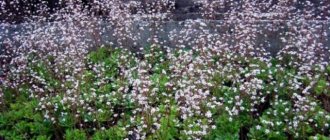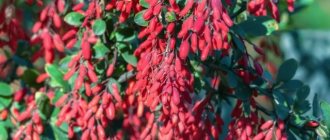Description of beautiful plants
Pink peonies live in their natural environment throughout Russia. They prefer sunny places, but can often be found in the shade. In the latter case, the bud will be smaller and the foliage system will be more developed.
There are two main types of pink peonies:
- Tree-like, the size of which can exceed 1.5 meters. The bush can have about 70 buds. A distinctive feature of these varieties is that they do not die off in winter. In their natural environment, they can be found in southern Russia and China, where winters are mild. These plants have a tree-like stem, the buds reach 20 cm in diameter. The first flowering occurs in the third year.
- Herbaceous - flowers whose height reaches 100 cm. Buds up to 20 cm, fleshy. The stems are powerful. The first flowering occurs after 2–3 years.
There is also a division according to the type of bud:
- Terry - distinguished by a large number of petals. The stamens also have the shape of petals, but there are also varieties with the traditional type of stamens.
- Non-double - they have from 5 to 10 petals surrounding the core in two rows. The pistil and stamen are located in the center.
- Semi-double - have five or more petals. In the center you can see traditional or petal-shaped stamens and pistil.
- Japanese or transitional. The stamens have a yellow tint. The flower is considered to be something between a double and non-double type, so they decided to highlight it separately. It first appeared thanks to the work of Japanese breeders.
- Crown - similar in appearance to a crown. Inside it are the inner petals, stamens and pistil.
- Anemone-shaped - have short petals on top and long ones below. The bud has a spherical shape.
Important. The uniqueness of pink peonies lies in the fact that each variety has its own unique shade. There are soft pink tones and very bright ones, reminiscent of fuchsia.
This crop has a rapidly growing root system. The buds are underground. Today there are more than 5 thousand varieties of peonies, and approximately 30% of this number are pink.
Long-flowering
ITO hybrids have a long flowering period (2-3 weeks). This is achieved due to the gradual opening of the apical buds and the late growth of lateral shoots, on which flowers also develop. Known ITO hybrids:
- Bartzella - yellow flowers with raspberry-orange spots in the center;
- Yellow crown - double and semi-double buds of yellow-lemon color with the thinnest delicate petals;
- Canary diamonds – the ruffled petals have a creamy yellow color, with a cherry-colored spot in the center;
- Cora Louise - pale lilac-pink petals, brighter lavender center.
Coral Sunset, Red Grace, and Garden Treasure also bloom for a long time and stand as cut flowers.
Reference: ITO peonies bloom for up to 2-3 weeks, medium-double peonies - 12-14 days, shorter life expectancy for non-double species - 6-10 days.
Popular varieties of pink peonies with photos
There are many varieties of pink peonies that are popular in Russia. These flowers look very beautiful. With the right choice of varieties of these plants, you can achieve flowering throughout the summer. That is, some buds will begin to fade, while others will begin to bloom.
It is worth considering the most popular varieties of pink peonies that gardeners grow on their plots:
- Pink Double Dandy (Pink) is a hybrid obtained from crossing a tree peony and a herbaceous peony. This variety has a powerful stem, the color of the bud gradually changes during flowering. Usually it is bright at first, but gradually the color becomes less pronounced. In the center you can find yellow blotches. The stamens are bright golden. They are clearly visible when the bud opens.
- The pink cloud is a flower, the height of the bush does not exceed 90 cm. The bush can produce up to 5 large double flowers, the diameter of which is about 20 cm. Flowering occurs in July. This is a tree-like peony variety that blooms 3–4 years after planting.
- Karl Rosenfeld is originally from China. A herbaceous type that can often be found in landscaping. The bush of this flower reaches 100 cm in height and width. Sweetish aroma, flowering time - late July. Tolerates harsh Russian winters well. The bud reaches 25 cm in diameter.
- Bowl of Beauty is distinguished by unusual flowers. They are pink, but white inside, with yellow splashes. Their size is about 20 cm. Purple and lilac peonies of this variety can be found in nature. Flowering occurs at the end of May and continues until about mid-June. The height of the bush is no more than 80 cm.
- Sorbet has relatively small double-type flowers, the diameter of which reaches 18 cm. Herbal type, so the bush does not reach more than 90 cm in height. The petals on the buds grow in three layers, the stamens have a petal shape. Curly leaves.
- Rosi Plena is a low-growing herbaceous plant, about 60 cm high. It is an early variety, so it must be planted in early May. The petals are corrugated, their length gradually decreases towards the center.
- Drezen Pink is similar in appearance to Pink Cloud. The flowers are double and spherical in shape. Their diameter is no more than 16 cm, and the height of the bush is about 80 cm. The stems are strong, the leaves are green. The buds appear late, which must be taken into account when composing the composition in the flowerbed. An important difference between these flowers and the Pink Cloud is the presence of silvery tips on the petals.
These are the most popular varieties of pink peonies that are grown in Russia today. However, there are other types of these flowers, which are also often used to decorate garden plots.
Important. If you take into account the flowering time when choosing varieties, you can ensure that the flowers are in the flowerbed throughout the summer. At the same time, they require minimal care. Most peonies are suitable for cutting and for landscape design.
Classification of peonies depending on flowering time
In order for peonies to bloom in your garden from May to July, you should plant plants with different flowering periods. There are 7 groups of peonies in total, which bloom one after another:
- very early - before June 5,
- early - from June 5 to 10,
- mid-early - from June 10 to 15,
- average – from June 15 to June 20,
- mid-late – from June 20 to 25,
- late – from June 25 to 30,
- very late - after June 30.
Peonies are very diverse flowers that can grow in any garden. And not only because of its unpretentiousness, but also because every gardener will definitely find his favorite variety among the 5 thousand existing ones.
Other varieties with delicate buds
There are still many peonies that are classified as pink, but their buds can have crimson, scarlet, lilac and other colors. It is worth taking a closer look at what other varieties Russian summer residents often grow on their plots. In this case, the gradation will be based on the color of the bud.
Raspberry color
You can often see peonies of this color; they also belong to the pink group. The most famous are the following:
- Striped lollipop - has buds up to 25 cm in diameter, which are crimson and white in color. This amazing combination makes it look like ice cream or candy, which is why this variety name appeared. When the flower fully blooms, you can see orange-yellow stamens. Peony blooms at the end of May for 5–7 weeks. The bushes reach 80 cm in height.
- Barbara is a variety with flowers up to 15 cm, which have a rich crimson hue. The bushes grow up to 70 cm in height. Dense stems hold buds well, which allows these flowers to be planted on a windy side.
- The Anastasia variety appeared thanks to the work of domestic breeders. The core of the bud has a bright crimson color, which gradually becomes less pronounced. The ends of the petals are slightly pinkish. There are yellow stamens in the center. The plant tolerates low temperatures well, so it grows in the northern part of Russia in its natural environment. It can also not be watered for a long time.
These are the main raspberry varieties that Russian gardeners grow on their plots.
Important. You should not grow several varieties with the same flowering time at the same time, as this can lead to the appearance of new types of peonies. Uncontrolled selection will not determine how viable a new flower species is.
Scarlet
Here are a few famous scarlet peonies in Russia:
- Pink Hawaiian Coral. The flower width is up to 16 cm, and the bush does not grow more than 80 cm. This is an early variety that should be planted in early May. Pink Hawaiian Coral is highly resistant to cutting.
- Cherry Royal is classified as a scarlet peony. It has bright buds, the size of which reaches 16 cm. This variety blooms closer to August. The flowering period lasts up to 4 weeks.
- Felix Supreme is small in size. Bush up to 80 cm, buds up to 14 cm. This is a late variety, so it is one of the last to bloom on the site. The stems of the plant bend. The leaves are green, medium in size.
There are also other scarlet varieties. It is necessary to choose based on the flowering time and the composition planned for the flowerbed.
Lilac
Lilac varieties include:
- Nancy Nora - buds up to 18 cm, bush up to 90 cm. Petals can have different shades, depending on the flowering period: from pinkish-milky to lilac.
- Etched Salmon is popular among gardeners for its beautiful color. The petals are quite dense. If you look at the flower from a distance, it can be confused with a rose. This variety has excellent immunity to viral and fungal diseases. It also tolerates low temperatures well.
- Varenka - appeared thanks to the work of Russian breeders. Delicate terry-type petals do not exceed 20 cm in diameter. The bush is small, about 80 cm. The plant has strong immunity and grows well throughout Russia.
These are the main purple varieties that Russian summer residents use to decorate their plots.
Choosing a place to plant a yellow peony
Before planting flowers, you need to prepare the soil. The result largely depends on compliance with the rules of agricultural technology, taking into account the characteristics of this variety. Recommendations for site selection:
- Yellow peonies are planted in slightly acidic or neutral soil.
- Peony is a light-loving plant, but it will not tolerate sunlight for long. The plant needs partial shade. It is not recommended to plant in heavily shaded areas - this will negatively affect flowering. The inflorescence will break, stop blooming or stretch out.
- They are looking for a place that will protect the bushes from winds and drafts.
- The flowerbed should be in a well-ventilated place to avoid stagnant air, otherwise fungus will appear. Peonies should not be planted surrounded by walls that prevent air circulation.
- The landing site should not be near buildings. The heat reflected from them can destroy the plant.
- Do not plant next to trees and tall shrubs. Neighbors may not leave moisture for the peonies.
- The soil chosen is loamy from a mixture of sand, clay, and other impurities.
- If groundwater flows close to the surface of the earth, do not plant the plant in that place.
It is better to plant flowers in a clearing in the central part of the garden - there they will not be disturbed by trees and there will be no drafts or winds.
Yellow peonies
Important : the crop must be planted at least one and a half meters from premises, buildings, and tall bushes.
Early flowers
Early varieties ripen in late May or early June. They can produce large buds for several weeks. In this case, no special care is required.
Here are a few of these varieties:
- A scattering of pearls, with a Japanese bud. One bush can have over ten flowers, and the bush itself is short (up to 85 cm in height).
- Edulis Superba, the height of the bush reaches 120 cm. It has rich pink buds that reach about 10 cm in diameter. The aroma is persistent.
- Germaine Bigot is a soft pink color. The buds do not exceed 14 cm, and the bush grows about 80 cm high.
- Marshall MacMahon is a variety with double buds, the size of which reaches 12 cm.
- Sarah Bernhardt grows up to 100 cm. The bush can contain up to 10 buds at a time.
Finding flowers that will delight gardeners in early summer is not difficult. You just need to understand what color you want to see. Moderate watering and timely planting will allow the peony to grow quickly. However, the first flowers appear, as a rule, after 2–4 years.
Preparing the soil for planting
Flowers need to be planted and replanted in the fall, since the crop reacts poorly to spring planting - it may not bloom for a long time or disappears. It is recommended to plant seedlings on a hill or in high flower beds. This way, excess water will drain quickly and the roots will not rot. If the soil is wet, drainage is done: the hole is deepened by 15 cm, the additional space is filled with gravel and brick.
Transplanting peonies
Pink peonies
Dig a hole 60 centimeters deep and 70 cm in diameter - this promotes good root development. When planting several plants, you need to maintain a distance of 70 cm between neighbors. The earth mixture should include three tiers:
- The very first 30 cm is filled with peat, rotted manure, and ash. Add 200 grams of slaked lime to clay and loamy soil.
- Straw connected to the ground, rotted grass, and leaves are poured into the middle tier.
- The upper tier is filled with a mass of sand and soil for clayey areas. Sandy soil is combined with clay.
The rhizome grows well in loose soil, so the area needs to be loosened. The plant should be planted so that the soil lies in a layer of 5-7 cm above the upper buds, and 3 cm for clay soil.
Transplanting a crop along with the soil helps it to take root better in a new area. When the root is divided, the plant needs careful care.
Important: in the spring, check how peonies are planted. If the buds have disappeared, dig up the soil with the rhizome a little and add more down.
Rules for caring for peonies in autumn and spring
1. Completely cut off withered stems and leaves when frost sets in, and burn them to kill any pests that may have settled in them.
2. Sprinkle the remaining parts of the stems with ash (2 - 3 handfuls per bush).
3. In spring, water the bushes abundantly (but not often), 2 - 3 buckets per adult bush. Moisture is especially important for peonies in early spring (during the period of rapid growth), when the plant lays buds and blooms, as well as in August - September when new buds are formed.
4. Loosen the soil after watering and remove weeds . Do not let water get on the leaves.
5. Feed peonies with potassium permanganate
immediately after the snow melts (2 - 3 g per 10 liters of water for 2 bushes).
Feed peonies immediately after the snow melts (2 - 3 g per 10 liters of water for 2 bushes)
6. Feed the plants with ammonium nitrate (15 g of nitrate per 10 liters of water) when the shoots begin to grow.
7. Starting from the second week of May , water young plants once a month on the leaves with a solution of complete mineral fertilizer in the recommended concentration. Use a watering can with a sieve. To prevent the solution from flowing down the leaves into the soil, add washing powder to the solution (1 tablespoon per 10 liters of water).
8. Fertilize peonies in the evening or on cloudy days.
9. During the budding period, mineralize the soil with a solution of mineral fertilizers (10 g of superphosphate, 7.5 g of ammonium nitrate and 5 g of potassium salt per 10 liters of water).
10. Feed peonies after flowering (after 10 - 14 days) with a solution of superphosphate (10 g) and potassium salt (5 g) in 10 liters of water.
11. Alternate mineral and organic fertilizers.
12. Water, feed, weed peonies in a timely manner and loosen the soil under them in the summer, after flowering has ended.
13. Do not cut the stems too short if pruning in the fall is done before frost. Leave shoots with 3-4 leaves on the stem: the plant needs them to form replacement buds. Follow this rule when cutting flowers for a bouquet.
Video:
Anemoneaceae
The group of anemone-like peonies is distinguished by its splendor and special charm. The petals of these flowers are very open at the bottom and form a flat base. The upper petals are narrow, lancet, and stand almost vertically. They are painted in a basic tone or have a lighter, contrasting color. A rare and exquisite representative of the group is the Rhapsody variety - with pink outer petals and pale cream-colored inner mini-petals. Snow Mountain has a white base with a mass of creamy yellow curly petals in the center.











